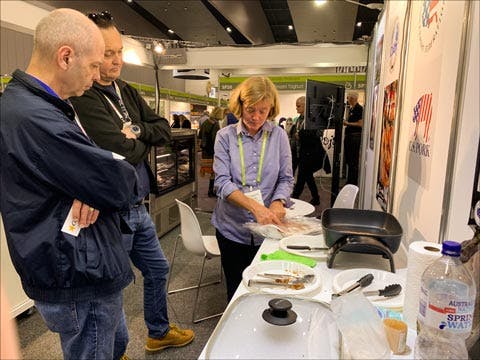Growing Interest in U.S. Pork Evident at Foodservice Australia
Samples of U.S. pulled pork and pre-cooked bacon were enjoyed by food industry professionals attending Foodservice Australia, an effort by USMEF to maintain the momentum U.S. pork has gained in the heart of the Oceania region. With funding from the USDA Market Access Program (MAP) and the National Pork Board, USMEF’s display booth also featured a variety of other U.S. pork products, including pork meatballs and riblet patties.

Visitors to the USMEF booth sampled many U.S. pork products, including pre-cooked bacon and pulled pork
Foodservice Australia is an annual food show that rotates between Sydney and Melbourne. The event, a gathering where importers and exporters meet to conduct business and learn about new products and market trends, moved to a larger venue in Melbourne this year and attracted 400 exhibitors, a 57% increase over its last Melbourne run in 2017.
According to Sabrina Yin, USMEF's ASEAN director who oversees activities in Oceania, the quality and taste of U.S. pork continued to impress chefs and other foodservice professionals from across the region.
“USMEF received many positive comments during the tasting sessions and there was a lot of buzz about the bacon and pulled pork, with many saying they have a hard time finding comparable products locally,” said Yin. “This was the fourth time USMEF participated in Foodservice Australia, and we’ve seen growing interest in U.S. pork each year.”
Australia is one of the fastest-growing markets for U.S. pork despite import restrictions, the most impactful being that U.S. pork must be cooked before it is sold in the marketplace. Although chilled or fresh U.S. pork cuts do not appear in retail meat cases, the U.S. market share for pork in Australia has climbed to 52 percent. In the first five months of 2019, the U.S. exported 48,110 metric tons of pork to Australia, up 45% from the same point last year.
This rise is due to demand for processed pork products and raw materials for further processing. Even though Australia has a strong domestic pork industry, it is estimated that at least 70 percent of the ham and bacon consumed in Australia uses imported pork.
Joel Haggard, USMEF senior vice president for the Asia Pacific, said changes in the cultural makeup of Australia are credited for the growing taste for pork, as a region once dominated by people with European backgrounds shifts to a population of newcomers who have Asian heritage.

USMEF’s display at Foodservice Australia featured several different U.S. processed and pre-cooked pork products
“Australia has this image as a beef nation, but just over two years ago something interesting happened – government statistics showed that the average Australian was consuming nearly 62 pounds of pork annually, slightly edging out per capita beef consumption, which has been in long-term decline,” explained Haggard. “That’s double the amount of pork the average Australian consumed in 1975. This reflects a diet diversification that in turn reflects a change in population demographics.”

USMEF received very favorable comments during the show about the quality and taste of U.S. pork
The changes in Australians' dietary and consumer preferences were very evident at Foodservice Australia, which included events such as a chef-of-the-year competition, school cafeteria workshops and a national restaurant conference, all highlighting new recipe ideas and menu concepts.
“USMEF representatives answered many questions from prospective buyers about U.S. pork products,” said Yin. “We also distributed a lot of U.S. pork brochures and factsheets, so it’s clear our work to increase awareness and interest in U.S. pork is paying off in this region.”
